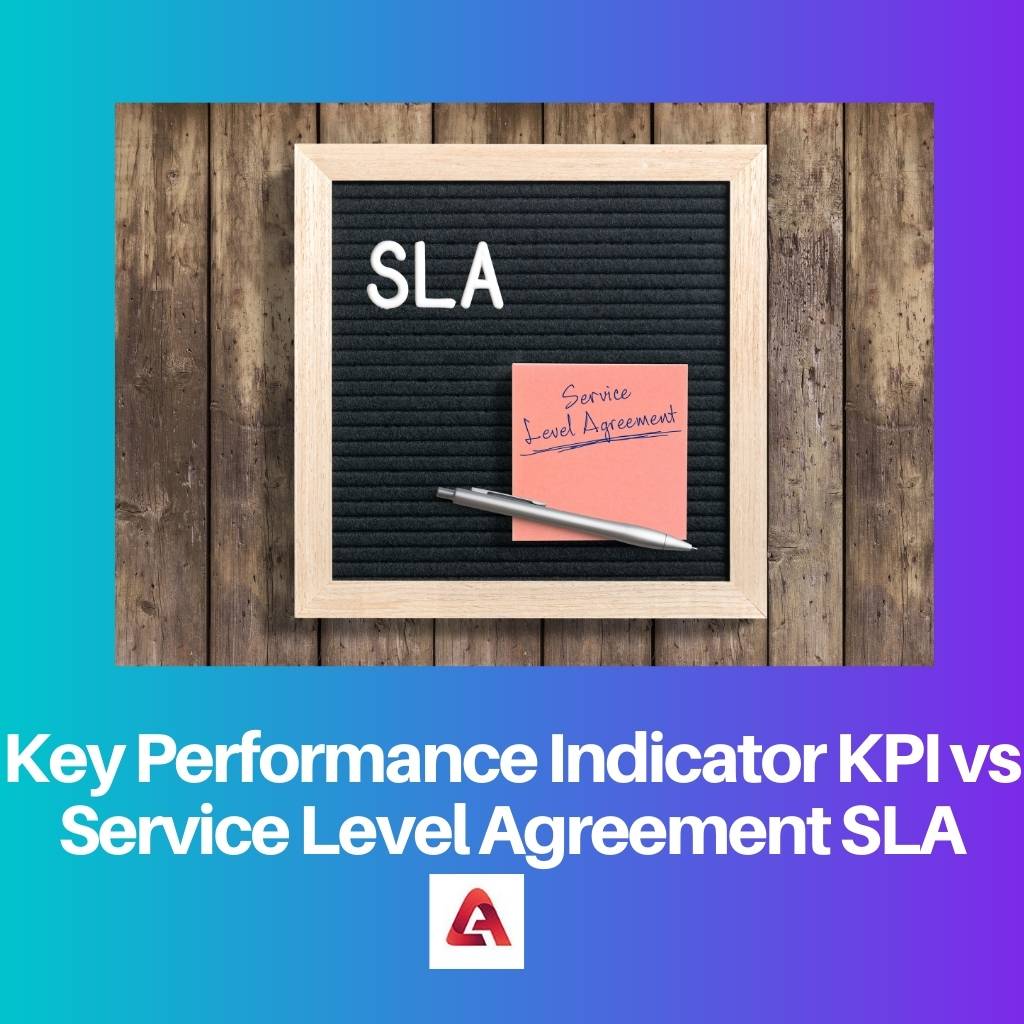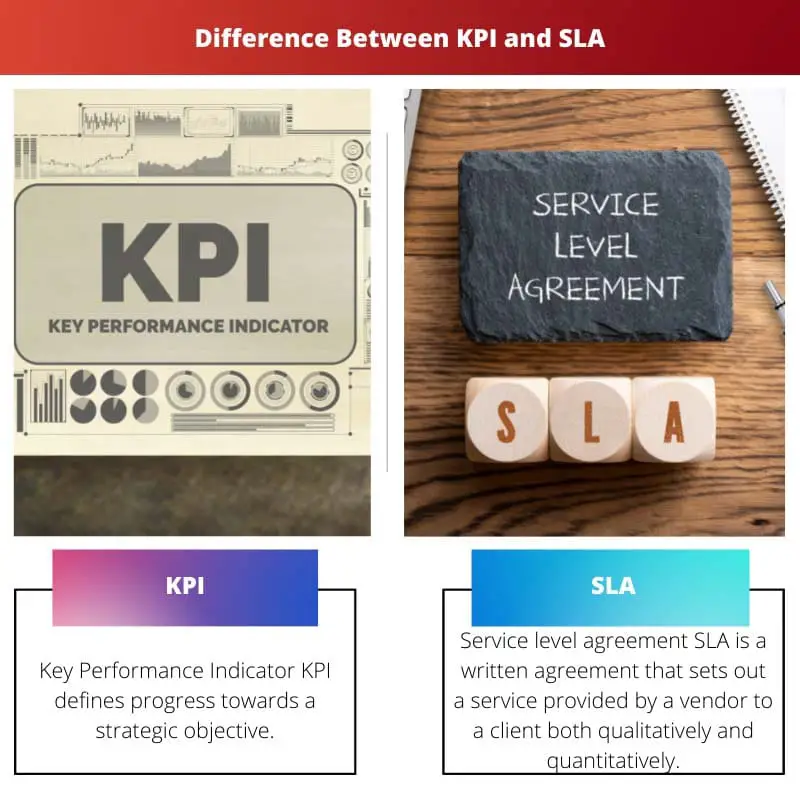SLA and KPI are aspects that are abbreviated as BPM of business process management. SLA means agreement on the level of service.
Cloud computing has converted strategic alternatives to in-app administration and IT services such that IT professionals and business managers are struggling to draw commercial value from other potential IT solutions for companies.
Key Takeaways
- KPIs are performance metrics used to measure the success of a business. At the same time, SLAs are agreements between a service provider and a customer that define the level of service to be provided.
- KPIs are used to track progress towards specific goals, while SLAs are used to establish service expectations and requirements.
- KPIs are used internally within a company, while SLAs are used externally to ensure that service providers meet the needs of their customers.
Key Performance Indicator KPI vs Service Level Agreement SLA
The difference between the key performance indicator KPI and service level agreement SLA is that the Key Performance Indicator (KPI) defines progress towards a strategic objective. A KPI provides an analytical framework for assessing progress towards specific goals. An SLA is a written agreement that sets out a service provided by a vendor to a client both qualitatively and quantitatively.

This is the tool to aid management in knowing how close or remote the team is to reaching a target and enables the team to adjust itself if it is out of pace to accomplish the strategic objectives by tracking progress towards the KPIs.
An SLA is also a performance measuring tool, although it differs from a KPI. This is an agreement between a service provider, internal or external, and the entity that uses this service.
Comparison Table
| Parameters of Comparison | Key Performance Indicator KPI | Service Level Agreement SLA |
|---|---|---|
| Meaning | KPI is a success evaluator. | SLA is a performance measuring tool. |
| Define | Key Performance Indicator KPI defines progress towards a strategic objective. | Service level agreement SLA is a written agreement that sets out a service provided by a vendor to a client both qualitatively and quantitatively. |
| Feature | looks ahead | concentrate on previous performance |
| Measures | Performance measurements | Ideal measurements |
| Suitable for | Large organizations | Public owned firms |
What is Key Performance Indicator KPI?
KPIs are statistic used in companies to determine the vital measures for an organization’s well-being and performance.
One example is a KPI for a public-owned firm, which may differ from a KPI for a person firm in its fund-raising circle in its quarterly returns.
It is difficult to identify meaningful KPIs. The identification of KPIs suitable for the organization depends, in large part, on the organization’s measurement capabilities.
Having defined and implemented KPIs, they must be updated continuously with indicators to ensure that the measurements enhance one another and that the actions and emphasis from other goals have not been wasted.

What is Service Level Agreement SLA?
An SLA is an external or internal legal document between a service provider and its clients. SLAs fulfil quality and performance expectations in various ways, both by the supplier and the consumer.
Similarly, an SLA might be available specifically to different consumers, depending on their demands, performance towards expectations, and diverse factors.
Service loans are a typical solution. The service provider here provides credit to the customer for a pre-established computation in the SLA.
Details about contingencies can also be found in an SLA. These are circumstances in which an SLA ensures and assists in the application of penalties when the provisions of the agreement are violated.
Main Differences Between Key Performance Indicator KPI and Service Level Agreement SLA
- KPI is the performance measurement, and the SLA are the ideal measurement.
- SLA fulfils quality and performance expectations in various ways, both by the supplier and the consumer, whereas KPI may not fulfil quality and performance sometimes as it is based on previous work.

- https://ieeexplore.ieee.org/abstract/document/6382487/?casa_token=0vWuhToq8tgAAAAA:IHX0c5lhasPJ3F5ntWoVC3togLyx9QUbqYd1u4JyBSMMKuZZwn8XhQAl6h3UhsPxndy_Z_sXPmc
- https://ieeexplore.ieee.org/abstract/document/6276255/?casa_token=AKcr__WyYscAAAAA:BWqXNvZJ4TV6KzXz1bOVAWxwxB3kFaHJiSOEGYDtxH3ZL7BCggpKvbiqZgU7sYmavWuxJzEKe7I

The delineation between KPIs and SLAs has been elucidated convincingly in this post. The examples provided have effectively showcased the practical applications of these business management tools.
An informative post that has delved into the nuances of KPIs and SLAs. The comprehensive coverage has provided valuable insights into these performance measurement and service agreement tools.
Key Performance Indicators (KPI) and Service Level Agreements (SLA) are critical aspects of business management. The difference between the two signifies the need for organizations to evaluate their progress towards specific goals and ensure that service providers meet their expectations.
The detailed comparison between KPIs and SLAs has facilitated a deeper understanding of these business management aspects. I appreciate the comprehensive information provided and look forward to applying this knowledge in practice.
The comparison table helped me understand the differences. I appreciate the information provided. Establishing meaningful KPIs and ensuring that the SLAs fulfill quality and performance expectations are essential in today’s competitive landscape.
This is a highly educational post that has given me the necessary information to understand KPI and SLA. AS an IT professional, I have realized the impact of cloud computing in managing IT services in today’s business environment.
The detailed explanation of KPIs and SLAs has broadened my understanding of their significance. I will be applying these concepts in my work to enhance our organizational performance.
An insightful post that has accentuated the critical nature of KPIs and SLAs in today’s business environment. The references provided have added credibility to the content. I look forward to further research on these topics.
The post has effectively highlighted the significance of KPIs and SLAs in measuring performance and establishing agreements between parties. As an IT professional, this information is crucial for understanding the evolving IT landscape.
This post has been an enlightening read. The delineation between KPIs and SLAs has provided valuable insight into how organizations can monitor progress and ensure a high level of service quality. A well-researched and informative piece.